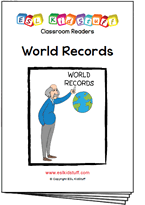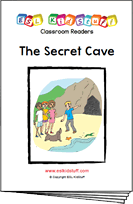Comparing things (Superlative adjectives) lesson plan
Stand-alone lesson ESL kids lesson plan
Lesson plans for ESL kids teachers
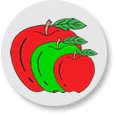
Comparing things (Superlative adjectives)
In this lesson, students practice comparing 3 or more things using superlative adjectives. They play a superlatives game, do a fun class survey and read an interesting story about world records.
Members get accompanying worksheets and classroom reader.
Download materials:
Our lesson plans are FREE!
Sign up for accompanying:
✔ worksheets
✔ homework sheets
✔ craft sheets
✔ flashcards
✔ song downloads & videos
✔ classroom readers & videos
Click to see lesson details, materials and supplies
Time: 40 mins – 1 hour
Objectives: Comparing objects using superlatives adjectives.
Structures: “This is the smallest” (the + adj+est), “That is the most beautiful” (the + most + adj).
Target vocabulary: tallest, shortest, longest, fastest, slowest, heaviest, biggest, smallest, newest, oldest, highest, youngest, cheapest, beautiful, [hide_on_uk]colorful[/hide_on_uk][hide_on_us]colourful[/hide_on_us], delicious, expensive, best, worst.
Lesson materials
Printables:
- Comparatives & Superlatives worksheet
- Class superlatives survey worksheet
- Compare monsters worksheet
- Reader worksheet
- Adjective word cards
Readers:
- World records
Additional materials:
- Comparing things – superlatives vocab crossword
- Comparing things – superlatives vocab word search
- Comparing things worksheet
Supplies:
- one pencil per group
- board with marker / chalk
This lesson will help your students describe the world around them and make comparisons. This lesson should be taught after the Comparing things (Comparative adjectives) lesson as much of that lessons vocab will be recycled.
A superlative adjective compares three or more nouns and shows the noun with the highest degree. For example, “Mount Everest is the highest mountain in the world”. This compares all of the mountains in the world and shows that Mount Everest if the highest of the lot.
Superlatives take the following forms:
- the adj+est: in most cases, adjectives with 1 or 2 syllables take the “the~est” form (e.g. fast – the fastest / heavy – the heaviest)
- the most + adj: in most cases, adjectives with 3 or more syllables take the “the most ~” form (e.g. expensive – the most expensive / beautiful – the most beautiful)
- there are a few exceptions to the above rule (e.g. modern – the most modern)
- irregular forms: “good” and “bad” take the irregular forms “the best” / “the worst”
Lesson procedure:
Warm up and maintenance:
The beginning of your lesson is extremely important: this is where you set the tone of your lesson and get everyone in the right frame of mind for learning English. It is also an opportunity to check homework and review previous lessons.
Click for warm up suggestions for the start of your lessons
These activities can be done in the following order at the start of your lesson:

1. Greetings and name tags
Greet the students by name as they enter the classroom and gesture for them to sit down. Before class prepare some blank name tags (stickers or pin-on tags). Give these out and have everyone write their names and put their tags on. If you use pin-on tags, you can keep and give out every class.

2. Homework check
Check each student’s homework set in the last lesson. Ask each student some questions about their homework worksheet (e.g. “what [hide_on_uk]color[/hide_on_uk][hide_on_us]colour[/hide_on_us] is it?”), give lots of praise, and then put some kind of mark on the homework sheet (e.g. a sticker, a stamp or draw a smiley face). Finally, tell your students to put their homework back into their bags.
3. Review past lessons
Reviewing past lessons is very important – students need constant practice of new vocab, structures, songs, games and so on. Always review parts of your last lesson as well as some parts from other previous lessons. You can spend 5-10 minutes reviewing – it’s fine to recycle games and activities from your past lessons to review as kids enjoy playing familiar games (although be careful not to play a game to death!). See the section “Other ideas to include in your warm” below for ideas.
You can also include review activities in the main body of your lesson. Kids can have short attention spans so it’s good to be able to pull out lots of activities during different stages of the lesson.
Other ideas to include in your warm up:
Ball pass questions
This is good to review questions from previous lessons. Get everybody standing in a circle.
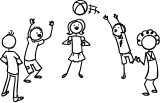
Round 1:
Take a ball and hold it and say, “My name is (you name)”. Then throw the ball to one student and say, “What’s your name?”. Students throw the ball around randomly, saying their names and asking for names.
Round 2:
This time ask a review question, e.g. “How many tables are there?”. Then throw the ball to a student who should answer, “There are (6) tables”. Help if necessary. Then that student throws the ball to another student and asks a “How many …?” question. Continue so everyone has a go. You can have multiple rounds with different topic questions.

Play “Spin the bottle”
Sit students in a circle with a bottle in the middle. Teacher spins the bottle. When it stops spinning the student it is pointing to has to answer a question. If the answer is correct then that student can spin the bottle. This is a good class warm up activity (e.g. How are you? What’s your [hide_on_uk]favorite[/hide_on_uk][hide_on_us]favourite[/hide_on_us] food? How’s the weather today?, etc.
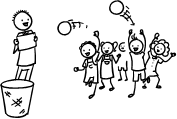
Play “Vocabulary basketball”
This is a fun game which reviews vocabulary from previous lessons. You will need a basket (a trash can) and 2 balls (or 2 pieces of A4 paper scrunched up into balls).
Form 2 teams and line them up so that two players from each team are facing the front with the basket in front of them. Let both players throw their ball – if they get their ball into the basket they can try and win a point by giving the correct answer to a question the teacher asks. This can be an actual question (e.g. What are you wearing?) or a flashcard (What’s this?). Then they go to the back of the line. At the end, the team with the most points is the winner!
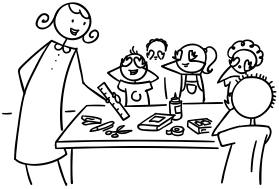
Play “What’s missing?”
This is a fun review memory game – students will have to try to remember review objects from previous lessons (e.g. classroom stationery). Lay the objects out on a table for all to see. Allow the students a minute to memorize the positions of the objects. Remove an object and hold it behind your back. Say, “Open your eyes!” – the first student who can shout out the missing object wins a point for his/her team. Play for all the objects.
Finally, calculate which team has won the most points and give them a round of applause.

Play “Quiz game show”
This is a fun quiz game, like a simple version of a TV game show. Draw some circles on the board and randomly write numbers 1, 2 or 3 in each circle. These will be points.
Put students into teams. Then ask the first team to choose a number – 1 is an easy question (e.g. “Do you like bananas?”) and 3 is a difficult question (e.g. point at a clock and ask, “What time is it?”). 2 will be in between in terms of difficulty. When the question has been answered correctly, erase that number circle. Play until all the number circles are gone – the team with the most points is the winner!
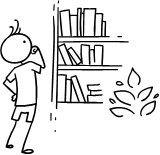
Read a classroom reader again
As you progress through the lessons you will start to build up a catalog of classroom readers (see our Readers download page at https://www.eslkidstuff.com). Kids love going back to old stories and reading through them again. Invite a student to pick a classroom reader and read through it as a class. Make the story as interactive as possible by asking questions (e.g. what [hide_on_uk]colors[/hide_on_uk][hide_on_us]colours[/hide_on_us] there are, the names of different objects, etc.) and getting students to speculate what is going to happen next in the story.

Talk about the weather (do after you have taught the weather lesson plan).
- Prepare a weather board. Before the first class prepare a piece of cardboard and cover it with felt – you are going to pin this to the wall. If you can, try and get blue felt (to represent the sky). Write at the top in large letters, “How’s the weather today?”. Below that write “Today it’s”. Cut out weather pictures (such as our weather flashcards) and stick some velcro on the back. Arrange the weather pictures around the edge of the board and then put the board on the wall of your classroom. You can now use this weather board at the beginning of every lesson.
- Ask about the weather. Ask, “How’s the weather today?” and have students put up their hands. Allow one weather condition per student (e.g. “It’s rainy”) and have each student come up and put a weather picture on the weather board.
- Introduce more weather vocabulary. Depending on weather conditions, you can introduce more weather words (with pictures … you can get students to draw them), such as:
- stormy
- misty
- showery
- freezing
- humid
- frosty
- icy
- drizzly
New learning and practice:
1. Review adjectives – play “Pictionary”
In the last lesson (comparative adjectives) students learned a lot of new adjectives. Let’s review these by using the word cards from last lesson (you can find these cards at the end of this PDF printable lesson plan – there are two extra cards: high and young – don’t use these yet).
Before class print the set of word cards from last lesson or cut out the word cards at the end of this PDF lesson plan.
You are going to play “Pictionary” on the board with the whole class. Select a card but don’t show anyone. Look at the adjective and then draw a picture to represent it on the board. For example, if the word is “tall”, draw a tall tree. Get students to call out until someone says the adjective … you may need to help a bit (e.g. indicating the tree is TALL by drawing a small person at the bottom).
The person who shouted out the right answer gets to come to the board, select a card and draw a picture. Play until all of the cards have been used.
2. Review comparatives and teach two new adjectives
Clean the board. Draw lines to divide the board into 4 squares (see below). Draw an apple in the top-left square and elicit the word “apple”. Then draw a bigger apple next to the first apple. Under the first apple write “big” and say, “This apple is big”. Then point at the 2nd apple and say, “But this apple is …” and elicit “bigger”. Write “bigger” under the second apple.
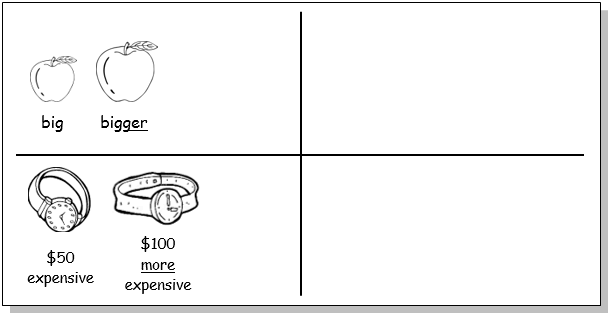
Then do the same in the bottom-left square for the adjective “expensive” (and “more expensive”) using a picture of a watch.
Next, using the word cards from the Pictionary game, randomly say an adjective (e.g. “beautiful”). Students need to slap their desks with their hand if they know the comparative form (e.g. “more beautiful”). Ask the first student who slapped his/her hand for the answer and award 1 point if correct. Play until all the adjectives have been used – the student with the most points gets a round of applause.
Finally, let’s teach two new adjectives: high and young:
In the top-right square of the board, draw a mountain. Elicit “mountain” and teach/elicit “high” and write it under the mountain. Chorus “high” 3 times. Then elicit the comparative form “higher” and write this under a higher mountain – chorus 3 times.
In the bottom-right square, draw a baby. Ask the class “Is the baby old?”. Elicit/Teach “young”, write it on the board and chorus 3 times. Then elicit “younger”, write on the board and chorus 3 times. Your board will now look like this:
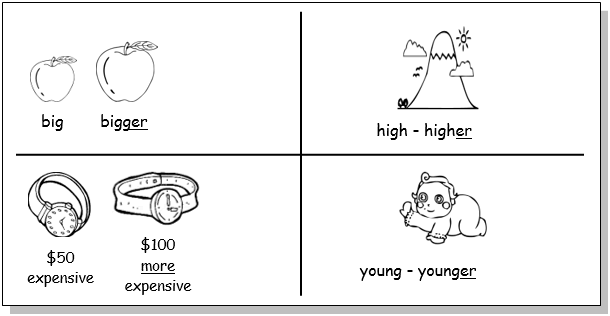
3. Play “Comparative cards spin the pencil”
Before class print out enough of the adjectives word card sets from the bottom of the PDF printable lesson plan so that each group of 3-4 students has a set of cards.
Put students in groups of 3-4 around a table and put the set of cards face down on the table. Student A takes a card and reads the adjective to the rest of the group. He/She then takes a pencil and spins it on the table. When the pencil stops spinning the person who it is pointing at must say a sentence using the adjective on the card in the comparative form, for example:
- heavy: This bag is heavy but that bag is heavier.
- delicious: Pizza is delicious but chocolate cake is more delicious.
- good: Harry Potter is a good movie but Star Wars is a better movie.
You should model this with one group to the rest of the class so that everyone fully understands the game. It is worth writing the sentences from the model on the board so that students have a structure to follow.
As the game is being played, write down sentences you hear on the board (some correct and some with mistakes). When everyone has finished, bring everyone’s attention to the board. Read out the first sentence and ask if it is correct or not. If it is correct, put a [hide_on_uk]check[/hide_on_uk][hide_on_us]tick[/hide_on_us] (✓) next to it. If it is wrong put a cross (X) next to it. Then have the groups discuss how to correct the mistakes and finally report back to the teacher to correct on the board.
4. Teach superlative adjectives (the adj+est / the most + adj)
Go back to the board from point 2. In the apple square draw a 3rd apple, bigger than the other two. Say, “This apple is big. This apple is bigger. This apple is the biggest!”. Then write “the biggest” under the 3rd apple. Chorus three times.
Then do the same with the other three squares as below. Your board will look like this:
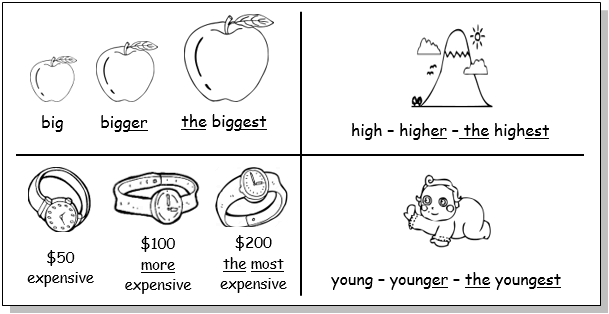
5. Do the “Comparatives & Superlatives” worksheet
Give out the “Comparatives & Superlatives” worksheets and have students fill them in, drawing and writing their ideas.
Start by showing what to do, for example, first point out the “taller” and “the tallest” trees and words in the first row, then model writing “smaller” and “the smallest” as well as drawing smaller men.
As students are working on their worksheets circulate and help out. When everyone has finished, go through the worksheet by eliciting and writing the answers on the board.
6. Students test each other on comparatives and superlatives
Place students in pairs. Student A looks at his/her “Comparatives & Superlatives” worksheet and Student B turns over his/hers. Student A starts by giving a short sentence with the adjective and Student B says the comparative and superlative forms, for example:
Student A: An old book.
Student B: An older book. The oldest book.
Student A: A beautiful bird.
Student B: A more beautiful bird. The most beautiful bird.
Pairs change roles after completing the test.
Finally, have all students turn over their worksheets and stand up. For each student, say a sentence with an adjective and that student to change your adjective example into a comparative and superlative. They can sit down if they give a correct answer. For example:
Teacher: David, a cheap car.
David: A cheaper car. The cheapest car.
Teacher: Good job! You can sit down.
7. Play “Let’s compare things on the table”
Put students into groups of 3 or 4 and have them sit around a table. Start by modeling the activity with a group. Choose an object that all the students have, such as a pencil, pen, pencil case, bag, [hide_on_uk]cell phone[/hide_on_uk][hide_on_us]mobile phone[/hide_on_us], shoe, notebook, etc. and get each student to place one of theirs on the table. Then students compare their objects, for example:
Student A: (pointing) A [hide_on_uk]colorful[/hide_on_uk][hide_on_us]colourful[/hide_on_us] pencil case.
Student B: (pointing) A more [hide_on_uk]colorful[/hide_on_uk][hide_on_us]colourful[/hide_on_us] pencil case.
Student C: (pointing) The most [hide_on_uk]colorful[/hide_on_uk][hide_on_us]colourful[/hide_on_us] pencil case!
Have the groups use as many items as possible as they practice. Walk around the room and help out with vocab and mistakes.
Finally, have each group present one of their conversations to the class.
8. Read classroom reader “World records”
This reader helps to reinforce the vocab and structures practiced in the previous activities. Before class, download and print off the reader “World records”. As you go through each page, have students guess the answers to each question before letting them see the picture (as the picture will have the answer!), for example:
Teacher: (reading from page 2) “First up, which is the fastest land animal in the world?”
Students: A horse? A tiger? etc.
Teacher: Hmm. Let’s see. (reading) “The answer is … the cheetah!”. Wow, really! (Showing the picture on page 3). I wonder how fast it runs? Any ideas?
Students: 100 km/h?
Teacher: (reading) “The cheetah can run at a top speed of 120 km/h (75 mph), which is super fast!”. Wow, that is fast, isn’t it? That’s how fast I drive my car on the [hide_on_uk]highway[/hide_on_uk][hide_on_us]motorway[/hide_on_us]!”
etc.
At the end of the reader there is a quiz. You can do this as a whole class or in teams.
Alternatively, watch our video version of the reader (Internet connection required).
9. Do the “Class superlatives survey”
Give out a “Class superlatives survey” sheet to each student and have everybody stand up and mingle to write the names of students on their surveys. If you have a large class you can split into groups of 8-10 students to do their surveys. The activity may get a bit hectic but it will be great fun as students decide on important questions such as who has the biggest smile and is the fastest speaker.
At the end of the activity, collate all of the induvial survey answers to decide which student wins the popular vote for each category.
Wrap up:
Assign homework: “Compare monsters” worksheet
Click for wrap up suggestions for the end of your lessons

1. Assign homework
Each week give out a homework worksheet for your students to take home. Hold up the homework worksheet and model how to do it. Give out the worksheets and say, “Put your homework in your bags”.

2. Do “Quick check”
Time to leave the class. Make sure everything is put away and the students have gathered their belongings. Have them line up at the door and place yourself between the door and the students. For each student check one new word or phrase, for example:
- hold up an object or flashcard (such as an item of clothing) and ask, “What’s this?”
- ask a question from the lesson (e.g. “Where do you live?”, “Do you like bananas?”, “Can you play chess?”, etc.)
When they give you the correct answer say goodbye and let them leave. If their answer is wrong, have them go back to the end of the line – they will have to try again once they reach the front!
Other lesson plans
Actions, verbs & tenses:
- Can – for ability
- Morning routines
- Daily routines & times of the day
- Actions – Present continuous
- Future plans using “going to”
- Past tense activities – Regular verbs
- Past tense activities – Irregular verbs: Part 1
- Past tense activities – Irregular verbs: Part 2
Adjectives:
- Describing people
- Describing things
- Comparing things (Comparative adjectives)
- Comparing things (Superlative adjectives)
Adverbs:
Alphabet:
Animals:
Body:
Classroom:
Clothes:
Colors:
Colours:
Directions:
Family:
Feelings & emotions:
Food:
Health & sickness:
Holidays & festivals:
Jobs:
Likes, dislikes & favorites:
Likes, dislikes & favourites:
- Likes & dislikes
- [hide_on_uk]Favorites[/hide_on_uk][hide_on_us]Favourites[/hide_on_us] and asking why
Nature & Our world:
Numbers:
Places & where we live:
Prepositions of location:
Pronouns:
Shapes:
Shopping:
Sports:
Time, days, months, seasons:
Toys:
Transport & travel:
Weather:


